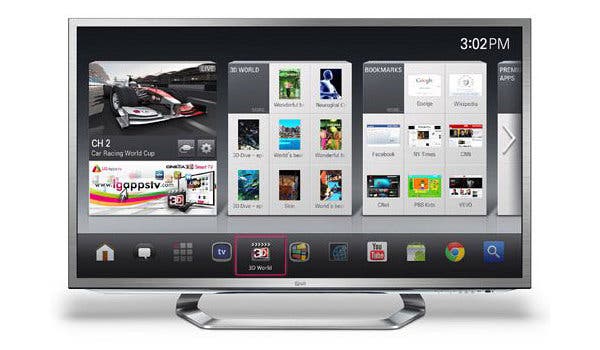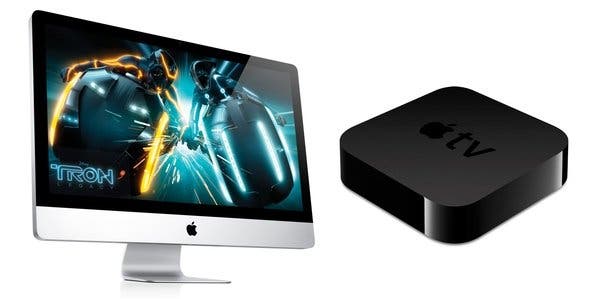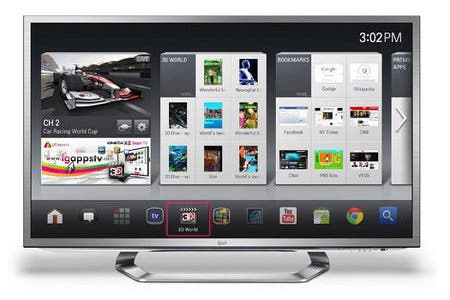Trends of 2012: The Rise of the Smart TV
Will Apple change everything... again?
Who needs a home console if your new TV already has one built-in? A new breed of gogglebox will emerge this year offering much of the functionality of current smartphones and tablets, with streaming Cloud gaming supported too. If rumours are to be believed, Apple will be launching its own Smart TV too - and who'd want to bet against their product being anything other than a unmitigated success?
Smart TVs are nothing new of course - Samsung has been knocking them out for a few years now, combining their generally impressive displays with internet connectivity, allowing for easy viewing of websites and services like YouTube and BBC iPlayer. Typically running lower power CPUs on a Linux core along with dedicated hardware for demanding functions such as video decoding, apps can be downloaded, and movie files run with ease direct from USB sticks. The TV's capabilities can be updated in much the same way as a traditional home console - via downloadable firmware updates.
"The hardware inside these screens can't really compete with the PlayStation 3 or Xbox 360 - but consumer electronics manufacturers are still looking to encroach on Sony and Microsoft's turf via Cloud-based gameplay streaming."
It's very early days in terms of the development of a game platform of course, but already unofficial emulators are appearing (yes, TVs can be hacked too) and Samsung's latest Smart TV SDK update includes support for USB game controllers. In the here and now, the hardware inside these screens isn't likely to produce the same kind of quality experience we get from PlayStation 3 or Xbox 360 - but consumer electronics manufacturers are still looking to encroach on Sony and Microsoft's turf.
At this year's CES, LG Electronics revealed that it has teamed up with Gaikai to add streaming gameplay to its new range of Smart TVs, and the playable demo on display looked impressive. At the same time, OnLive has recently released its Viewer app for Google TV devices, and promises that full gameplay is to come.
A New Host for Cloud Gaming
While we're yet to be convinced that Cloud gaming can satisfy core gamers in its current first-gen format, the fact is that even judged by OnLive standards, the service is good enough - and convenient enough - to appeal to a great many people, and if it's built-in as standard into your TV, obviously it's going to make people think twice about the need for buying a dedicated gaming box.
There's also a compelling argument that as the tech matures, so the quality of the service will improve - certainly from a picture quality perspective. Bandwidth becomes cheaper year-on-year, and the higher the data throughput, the better the image quality. OnLive streams at 5mbps - a level of bandwidth unthinkable not so long ago. As countries transition onto fibre-optic networks, 10mbps and higher (much higher) will become the norm, allowing for a much improved experience. Latency will always be an issue of course. Our tests with OnLive indicate that the service adds around 100ms-133ms to the responsiveness of the same game running on PC, but again, a general move towards fibre along with closer server locations will help here (OnLive UK is currently hosted in Luxembourg).

"Rumours continue to surround the notion of Apple releasing its own screen, apparently powered by iOS technology and using a voice-activated interface based on the Siri system employed in the iPhone 4S."
But what of the viability of the displays themselves as true console replacements, running local gameplay? At the moment, the specs are mostly underwhelming, and without any kind of mainstream, viable platform likely to make a profit, no serious publisher is likely to get behind the concept - unless of course we factor in the potential debut of the iTunes App Store. Rumours continue to surround the notion of Apple releasing its own screen, apparently powered by iOS technology and using a voice-activated interface based on the Siri system employed in the iPhone 4S.
Walter Isaacson's authorised biography describes how Steve Jobs himself talked about the product, with the man himself apparently saying, "I'd like to create an integrated television set that is completely easy to use... it would be seamlessly synched with all of your devices and with iCloud. It will have the simplest user interface you could imagine."
How Apple Can Make a Difference
Apple's advantages over its competitors are quite immense: it already has an established market for apps, games, movies and music - and the company brand is untouchable. It's also unique in that it has a single, unified architecture it rolls out across multiple platforms, making the potential market for developers and publishers so much more enticing. A Smart TV release on its own is unlikely to engender much support from publishers, but in concert with untold millions of iPod Touches, iPhones and iPads, the outlook looks decidedly different.
The Cupertino-based superpower is also well-placed in that its architectural improvements strongly suggest a focus on gaming performance. As we described in our Digital Foundry vs. iPad 2 article, even with its current A5 platform, the opportunity for quality games is immense. Dual core ARM CPUs in concert with PowerVR SGX543 technology can produce titles like the Unreal Engine-driven Infinity Blade 2 - certainly not "PS360"-quality but impressive enough to satisfy a different kind of gamer. Of course, any Apple TV would most likely ship with a more up-to-date chipset.
If an iOS TV is indeed planned for this year, it'll almost certainly feature the new A6 chip set to make its debut in the upcoming iPad 3. Recent developer betas for the operating system have strongly hinted at quad core support, and it's reasonable to expect that the final processor will have much in common with the powerful chip we find inside PlayStation Vita, which at a very basic level, is much like two iPad 2s bonded together: that's some serious rendering power.
Clearly, there are serious difficulties facing any kind of emergence of the Smart TV as a viable gaming platform - and this, we presume, is the problem that Steve Jobs reckoned he'd "finally cracked" before his untimely passing. Some might argue that the TV remote as it stands right now is an overly complex beast covering off a fairly basic level of functionality - the notion of creating an easy-to-use interface that is as intuitive as that of other iOS devices is a major challenge. Certainly there are no clues in the existing Apple TV set-top box, which ships with a conventional remote control. Hackers have demonstrated how Apple TV can run apps easily enough, but the notion of making them actually usable in a living room environment is the real litmus test and Siri-style access can surely only go so far.

Will It Be Worth the Upgrade?
"The basic reality is that manufacturers need to convince consumers that it's actually worth upgrading their existing displays - an argument that they failed to make convincingly with the arrival of stereoscopic 3D technology in 2009."
Over and above this is the basic reality that manufacturers need to convince consumers that it's actually worth upgrading their existing displays - an argument that they failed to make convincingly with the arrival of stereoscopic 3D technology in 2009. There's a deeply ingrained perception that the TV is the sort of thing you only upgrade once or twice a decade, and post-CES there's still no compelling argument that the functionality on offer justifies an upgrade.
YouTube, NetFlix and BBC iPlayer support is "nice" but not enough on its own to make people rush out to buy new screens, while it's difficult to imagine that elements such as browsing and social network support would really work in a living room environment. The other challenge facing the makers of the new breed of Smart TVs is that it is obviously much cheaper for consumers to buy an additional box at a much cheaper price that does all of these things any way. Just one example amongst many is the Sony BDP-S380 Blu-ray player: it's a sub £100 box that features Sony's Bravia internet functionality, running iPlayer, YouTube and other streaming video services and even HD movie files copied onto a USB stick.
There are even signs that the existing consoles are evolving, repurposing themselves to offer Smart TV-style functionality. The recently released Xbox 360 'Metro' dashboard may well have its problems, but it demonstrates how seriously Microsoft views the kind of functionality the new breed of TVs offers. In effect, it could be argued that the platform holder is expanding the functionality of its existing device in order to give you fewer reasons to defect away from the Xbox platform. And if the 360 evolves into a streaming media box, it can also stream gameplay too - a current gen console using OnLive/Gaikai tech to run next-gen titles is an intriguing possibility and may explain the dual SKU rumours currently circulating. Why launch two SKUs when the existing hardware could conceivably host Cloud versions of next-gen titles?
The emergence of a new wave of Smart TVs at CES demonstrates that manufacturers are intent on expanding the way we interact with our displays - and games will clearly play a key part in that. But to be successful, it's going to take an enormous content library encompassing all forms of media and the introduction of exciting, never-seen-before features. It's going to require the product design brilliance of a company accomplished in the art of selling us stuff we never knew we actually wanted, or needed.
Over to you, Apple.









